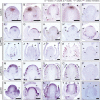Genetic architecture underlying variation in floral meristem termination in Aquilegia
- PMID: 35731618
- PMCID: PMC9756955
- DOI: 10.1093/jxb/erac277
Genetic architecture underlying variation in floral meristem termination in Aquilegia
Abstract
Floral organs are produced by floral meristems (FMs), which harbor stem cells in their centers. Since each flower only has a finite number of organs, the stem cell activity of an FM will always terminate at a specific time point, a process termed floral meristem termination (FMT). Variation in the timing of FMT can give rise to floral morphological diversity, but how this process is fine-tuned at a developmental and evolutionary level is poorly understood. Flowers from the genus Aquilegia share identical floral organ arrangement except for stamen whorl number (SWN), making Aquilegia a well-suited system for investigation of this process: differences in SWN between species represent differences in the timing of FMT. By crossing A. canadensis and A. brevistyla, quantitative trait locus (QTL) mapping has revealed a complex genetic architecture with seven QTL. We explored potential candidate genes under each QTL and characterized novel expression patterns of select loci of interest using in situ hybridization. To our knowledge, this is the first attempt to dissect the genetic basis of how natural variation in the timing of FMT is regulated, and our results provide insight into how floral morphological diversity can be generated at the meristematic level.
Keywords: Aquilegia; QTL; floral meristem termination; stamen whorl.
© The Author(s) 2022. Published by Oxford University Press on behalf of the Society for Experimental Biology. All rights reserved. For permissions, please email: journals.permissions@oup.com.
Conflict of interest statement
The authors declare no conflict of interest.
Figures





Similar articles
-
Quantitative live imaging of floral organ initiation and floral meristem termination in Aquilegia.Development. 2022 Feb 15;149(4):dev200256. doi: 10.1242/dev.200256. Epub 2022 Feb 17. Development. 2022. PMID: 35175330
-
Developmental and Molecular Changes Underlying the Vernalization-Induced Transition to Flowering in Aquilegia coerulea (James).Genes (Basel). 2019 Sep 22;10(10):734. doi: 10.3390/genes10100734. Genes (Basel). 2019. PMID: 31546687 Free PMC article.
-
All's well that ends well: the timing of floral meristem termination.New Phytol. 2023 Apr;238(2):500-505. doi: 10.1111/nph.18715. Epub 2023 Jan 18. New Phytol. 2023. PMID: 36600362 Review.
-
Genetic architecture of floral traits in bee- and hummingbird-pollinated sister species of Aquilegia (columbine).Evolution. 2021 Sep;75(9):2197-2216. doi: 10.1111/evo.14313. Epub 2021 Aug 12. Evolution. 2021. PMID: 34270789
-
Understanding the development and evolution of novel floral form in Aquilegia.Curr Opin Plant Biol. 2014 Feb;17:22-7. doi: 10.1016/j.pbi.2013.10.006. Epub 2013 Nov 15. Curr Opin Plant Biol. 2014. PMID: 24507490 Review.
Cited by
-
Loss of staminodes in Aquilegia jonesii reveals a fading stamen-staminode boundary.Evodevo. 2024 May 25;15(1):6. doi: 10.1186/s13227-024-00225-3. Evodevo. 2024. PMID: 38796457 Free PMC article.
References
-
- Ballerini ES, Min Y, Edwards MB, Kramer EM, Hodges SA. 2020. POPOVICH, encoding a C2H2 zinc-finger transcription factor, plays a central role in the development of a key innovation, floral nectar spurs, in Aquilegia. Proceedings of the National Academy of Sciences, USA 117, 22552–22560. - PMC - PubMed
-
- Bastida JM, Alcántara JM, Rey PJ, Vargas P, Herrera CM. 2010. Extended phylogeny of Aquilegia: the biogeographical and ecological patterns of two simultaneous but contrasting radiations. Plant Systematics and Evolution 284, 171–185.
-
- Bommert P, Nagasawa NS, Jackson D. 2013. Quantitative variation in maize kernel row number is controlled by the FASCIATED EAR2 locus. Nature Genetics 45, 334–337. - PubMed

